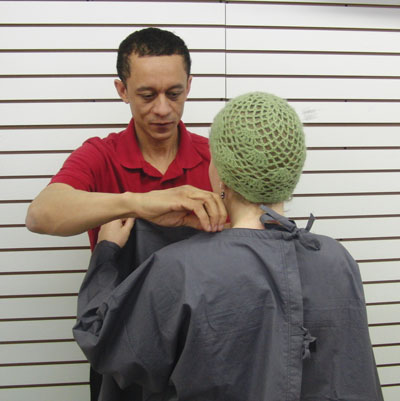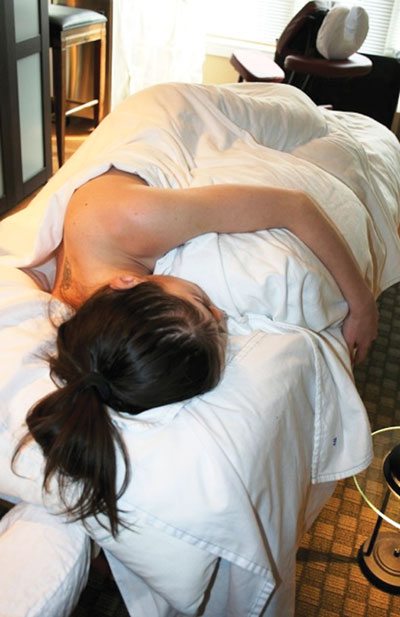
Features
Patient Care
Practice
Post-surgical Therapy for Mastectomy and Implants, Part 1
Should massage therapy be an integral component of the rehabilitation process for post-surgical cancer patients? Yes, absolutely.
April 5, 2011 By Paul Lewis RMT
Should massage therapy be an integral component of the rehabilitation process for post-surgical cancer patients? Yes, absolutely.
 |
| A robe can be worn by the patient while the RMT conducts the assessment.
|
I must ask why, then, the massage therapy profession is not considered, during roundtable discussions, as a recommended adjunct for post-surgical clients. When we have a cold, we generally think about visiting our family physician, and an increasing number of us may see a naturopathic doctor or even our pharmacist. But, when we require help to restore range of motion, reduce pain and address issues related to scarring and mobility, where do we think of going? Is it advertising and public perception that keep massage therapy in the background of treatment options, or are there just not enough of us engaged in the rehabilitative work to make a large enough impact?
I would like to share with you my experiences with post-surgical clients, outline treatment techniques I used during their rehabilitative process and offer the rationale for the modalities chosen. It is my hope that more of us will become engaged in helping post-surgical patients and raise awareness of the possible benefits that massage therapy has for the challenges these patients face.
REGULATED SCOPE OF PRACTICE
Whenever a client requests treatment from a Registered Massage Therapist (RMT), consent for treatment is always required. The College of Massage Therapists of Ontario (CMTO) standards of practice require consent for treatment from each and every client. Therapists are reminded that “full body” treatment may mean different things to different clients. Therefore, it is recommended that all body areas be discussed for inclusion or exclusion to a given session, but as well, special consent is required for sensitive areas such as the inner chest wall, inner thighs, buttocks and breast areas. It should also be noted that consent can be modified or revoked at any time by the client for any reason.
The CMTO defines the practice of massage therapy as the assessment of the soft tissue and joints of the body, the treatment and prevention of physical dysfunction and pain of the soft tissue and joints by manipulation to develop, maintain, rehabilitate or augment physical function, or relieve pain. In order to gain licensure with the CMTO, one must complete a training program from an approved Ontario school or equivalent (generally averaging 2000 hours of academic and clinical training), followed by successful completion of both written (multiple choice question) and Objectively Structured Clinical Examinations set by the CMTO. Once registered with the CMTO, you are able to practice as a massage therapist.
Even though treatment of the breast tissue is within our regulated scope of practice, many RMTs avoid treating this area. This is often due to lack of confidence, lack of knowledge or concern about public opinion.
KNOWLEDGE IS CONFIDENCE
I was first introduced to breast massage, its pathology and clinical theory by Debra Curties, instructor and director at Sutherland-Chan school and teaching clinic. She is an advocate of breast massage and women’s health, focusing specifically on indicators and health concerns for cancer patients. I am grateful to the instructors I had for the training and knowledge they provided. I am also interested in passing this knowledge and training on to others by offering presentations at workshops and conferences. Perhaps, if we maintain this cycle of knowledge, then breast massage, and the issues surrounding it, will become less intimidating for therapists and they will become more confident about treating clients who require their expertise and knowledge.
 |
|
| These patients may feel vulnerable and compromised — it is important to provide an environment that is secure and comfortable, and gives control for decision making back to them.
|
APPROACH TO TREATMENT
For my post-surgical rehabilitative treatments, I use a variety of skills and treatment modalities in addition to a technique called Dynamic Angular Petrissage (DAP). I find this engagement technique helps to augment the rehabilitative treatment and is not stressful either for the client or the therapist.
Assessment is vital to confirming your hypothesis, and to providing a rationale for the choice of modalities and treatment techniques employed. When a client presents with an issue or an injury, it is necessary to look not only at the area of referred pain, but also at related structures that may indirectly contribute to their symptoms or underlying cause of injury. The cause could be skeletal, muscular or neurological, or a combination of the three. Therefore best practice is to go beyond the standard health history and ask to perform a clinical/orthopedic assessment.
When clients are referred to me after having undergone radiation or chemotherapy for breast cancer, those clients are typically feeling vulnerable or uncomfortable with their bodies, and fearful about the extent of their injuries. There are a few simple steps that can be taken to help clients feel informed and comfortable about the process of receiving a therapeutic treatment. For example, at the beginning of the palpation and physical assessment, I suggest providing a robe that allows for some coverage of sensitive areas while allowing you to perform your assessment. (Personally, I use a Japanese, half kimono style of robe.) This helps reduce feelings of vulnerability, reinforces the feeling of security and reduces embarrassment regarding their changed appearance. As well, the client does not get cold during this assessment phase. These steps may seem unnecessary, but I see this small gesture as an essential part of building trust in the relationship.
INITIAL CLIENT PRESENTATION
The physical and emotional state of these women, before they start their massage treatments, can often be described as emotionally fragile and physically exhausted. Many feel their lives have been interrupted, that some of their sexuality been compromised, and may feel as though they have had minimal control over their bodies. I have witnessed the transformation of these courageous women, in just a few months, as they transition from feeling depressed and withdrawn to outgoing and confident. This transformation can be facilitated by some simple gestures. I find it helpful to create an environment that is comfortable and secure, and gives control (that is, decision making) back to the client.
It is important to take your time in explaining the various steps and procedures that are involved and the techniques you plan on using in their treatment. During the treatment of scar tissue or adjacent structures of the body, the massage may trigger emotions that overwhelm clients, bringing them to tears. When this happens, I do not attempt to verbally engage them. I stop all movement and maintain a firm, but gentle, contact. When clients regain their composure, I reassure them that this is a natural reaction. I then ask if they would like to break for a moment, or continue the treatment another day. Most clients are able to resume treatment. In my experience, for many of the women this emotional release is part of the healing process.
INDIVIDUALIZED ASSESSMENT AND TREATMENT
In my experience of having worked with individuals who have undergone a biopsy, single or double mastectomy, augmentation, reduction or transverse rectus abdominis myocutaneous (TRAM), I have discovered how critical it is that each client’s treatment plan is unique to her set of circumstances. This requires personalizing the assessment information, as well as any self-care exercises prescribed to the client, so that they are effective and realistic for the client to use in her particular lifestyle. I accomplish this by using various modalities – this combination contributes to the overall result.
In Part 2 of the article, the author will discuss in detail self-care exercises for post-operative patients who have undergone breast procedures, as well as treatment approaches he uses and the rationale for techniques and modalities utilized. It will appear in the Summer 2011 issue of Massage Therapy Canada.
Paul Lewis, practises out of his clinic in Mississauga, Ontario, and will be presenting at various conferences and teaching engagements in Canada, Europe and the United States (CEUS). For more details visit www.paullewis.ca.
| Letter from a wife, mother and cancer survivor |
| Ms. K sums up her experience with massage therapy and the synergy that resulted:
I just wanted to inform other survivors who are feeling depressed and self-conscious, as I did, that massage therapy improved my life! Having undergone mastectomy, chemotherapy and radiation therapy, my body was feeling foreign, weak and wounded. Surgery had left me with limited mobility on my left side; even combing the little hair I had left was a painful challenge. When I was referred to Registered Massage Therapist, Paul Lewis, for post-cancer rehabilitation, I was apprehensive about how my body would cope with yet another form of treatment. But with very limited rotation in my shoulder, along with restricted movement in my neck and a constant numbness and tingling in my hands, I felt I had little to lose from trying something new. As soon as he started his assessment of my condition, however, any worries I previously held went out the window. Paul explained every movement, stretch and therapeutic touch to ensure my comfort and ease. His recommendations for self-treatment were easy to remember and fit into my lifestyle with ease. During each session, he took extra measures with draping and positioning my body – this allowed me to relax completely throughout the duration of treatment. After only two months, once per week for 1.5 hours, my scar tissue has improved, and range of motion on my left side has been restored to nearly 90 per cent. I’ve gone from someone who could barely comb her own hair to someone who can once again swim with my kids while on our recent family vacation. I’ve begun to reclaim the things I enjoyed in life before my cancer diagnosis. I know it is difficult to think of going for further treatments after we have been through so much to battle the cancer, but you need to know that massage therapy is worth it to get your active life back. I would recommend it to other survivors, as well as to doctors, surgeons and therapists looking to refer their patients to someone who is both knowledgeable and sensitive to cancer-related trauma. |
Print this page